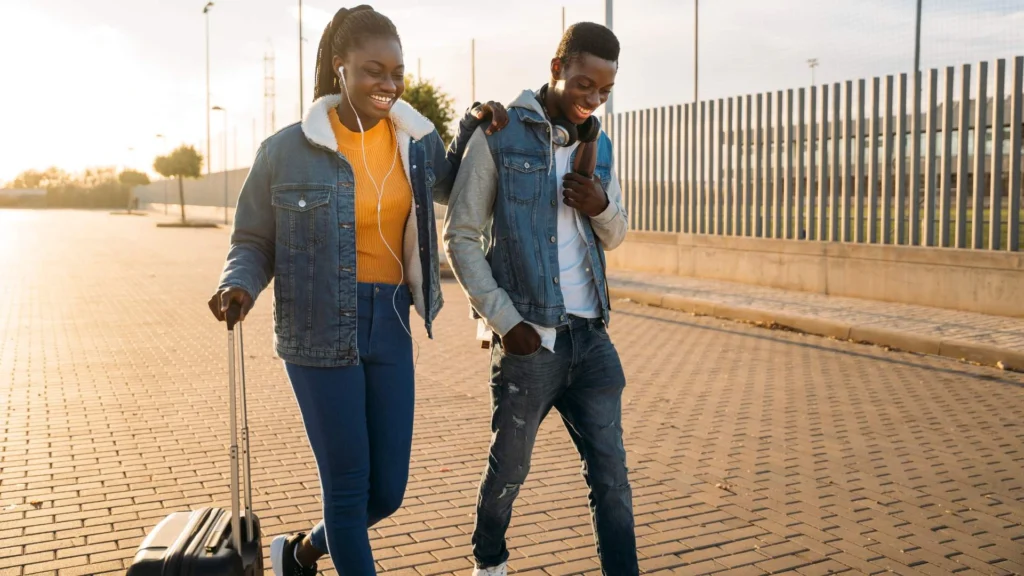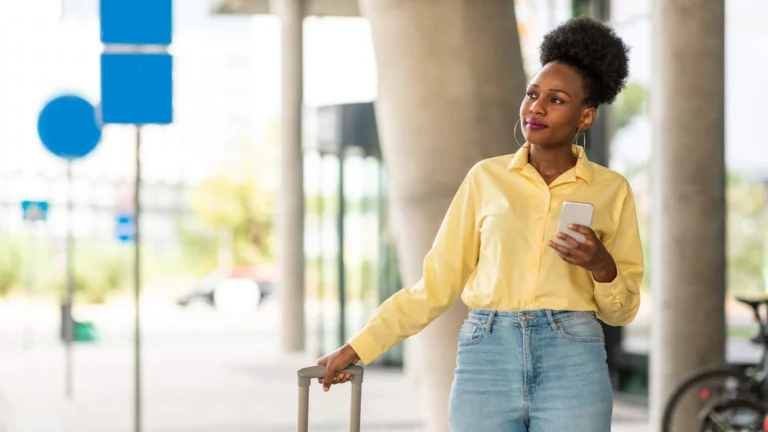Table of Contents
Travel is supposed to feel exciting, not stressful. But anyone who has been pickpocketed in a busy market, had their card skimmed at an ATM, or struggled to find their way late at night in an unfamiliar city knows how quickly things can go wrong. For solo travelers, families, and even groups on tight budgets, safety is often a top concern and one that can sometimes feel expensive to address.
The good news is that in 2025, technology has made staying safe while traveling not only easier but also more affordable. From free navigation apps to identity-protection platforms and AI-powered translation tools, today’s traveler has more digital allies than ever before.
This comprehensive guide on travel safety on a budget explores the 10 best digital tools in 2025, showing you how to protect yourself, your money, and your peace of mind, without breaking the bank.
1. Google Maps (With Offline Mode)
It may seem obvious, but Google Maps remains one of the most essential safety tools for travelers. In 2025, its offline mode has become even smarter, allowing you to download entire regions, transit schedules, and walking directions.
For budget travelers, this matters because you can avoid roaming fees, stay safe navigating neighborhoods without internet access, and reduce the risk of wandering into unsafe areas. Lost tourists are prime targets; with offline maps, you’re less likely to stand out.
Pro Tip: Before your trip, download maps for every city you’ll visit. Highlight safe routes, metro stations, and key landmarks so you’re never stranded.
2. Beem (Financial Safety Net)
Money problems abroad are not just stressful; they’re unsafe. Being stranded without cash can make travelers vulnerable. Beem provides a safety net with Everdraft, which gives instant access to funds for emergencies like replacement tickets, medical visits, or even a safe ride back to your hotel.
Beem also protects against fraud through identity monitoring and secures transactions with budgeting insights that help you stay on track. For group travelers, “Send Money, Pay Later” ensures you can split costs without handing over cash or relying on strangers.
Budget Angle: Instead of carrying wads of emergency cash (a theft risk), you have digital access to funds exactly when needed.
3. TripWhistle Global SOS
Knowing emergency numbers abroad is critical, but they vary widely. TripWhistle Global SOS simplifies this by instantly pulling up police, fire, and ambulance numbers in over 200 countries.
For solo or budget travelers without access to concierge services or tour guides, this tool can be lifesaving. If something happens, you won’t waste valuable minutes Googling “emergency number in Portugal.”
Budget Angle: It’s free and works without a local SIM, as long as you have Wi-Fi.
4. Trail Wallet
Safety isn’t only physical; financial safety is equally important. Trail Wallet is a budgeting app designed for travelers that tracks daily expenses across multiple currencies. Overspending may not sound like a “safety issue,” but running out of money in a foreign country often forces travelers into risky situations.
By helping you monitor every cent, Trail Wallet ensures you don’t get blindsided by dwindling funds. Think of it as prevention, because the safest traveler is the one who never puts themselves in financially vulnerable positions.
Read: Beem Pass: The Safety Net You Can Share With Friends
5. bSafe Personal Safety App
bSafe transforms your smartphone into a personal safety system. Features include live GPS tracking shared with trusted contacts, automatic alerts if you fail to check in, and even a fake phone call function if you need to get out of an uncomfortable situation.
For budget travelers staying in hostels or exploring nightlife alone, bSafe provides peace of mind without requiring expensive security measures.
Pro Tip: Share your live trip itinerary with a friend or family member through the app before you head out.
6. XE Currency
Financial scams thrive on confusion. XE Currency helps travelers avoid being ripped off by providing real-time exchange rates. Whether you’re at a currency counter, withdrawing cash from an ATM, or paying for a taxi, knowing the correct rate helps you negotiate confidently.
Budget Angle: Currency scams are one of the most common ways travelers lose money unnecessarily. A free app is often all it takes to protect yourself.
7. Rome2Rio
While primarily a route-planning app, Rome2Rio doubles as a safety tool because it prevents travelers from getting stranded. It shows how to get from A to B using buses, trains, ferries, or flights, often including schedules, prices, and booking links.
For budget travelers, this reduces the temptation to take expensive (and sometimes unsafe) last-minute taxis. It ensures you always know there’s a safe, affordable way home.
8. NordVPN (Virtual Private Network)
Public Wi-Fi is a budget traveler’s best friend, but also their biggest digital risk. Hackers often target airport lounges, cafés, and hostel Wi-Fi. A VPN encrypts your connection, protecting sensitive information like credit card details, flight bookings, and identity documents.
Budget Angle: While some VPNs require subscriptions, the cost is minimal compared to the risk of fraud or identity theft abroad.
9. Google Translate (With Offline Packs)
Communication breakdowns can become safety risks. If you can’t ask for help, explain allergies, or understand directions, you’re vulnerable. Google Translate’s offline packs allow real-time translation of menus, signs, or conversations without internet access.
For budget travelers, this reduces dependence on pricey guides or risky guesswork. It can also make solo travelers more confident navigating alone.
10. Smart Traveler App (U.S. State Department)
For U.S. travelers, the Smart Traveler app provides government-issued safety alerts, entry requirements, and location-based updates in case of emergencies. It’s essentially a pocket travel advisory system.
Budget Angle: It’s free, and by registering your trip with the STEP program, you gain an extra safety net — the local U.S. embassy knows where you are in case of crises.
Matching Safety Apps to Budget Traveler Needs
Here are some safety apps that can complement you during your travel abroad.
| Traveler Type | Safety Priority | Best Apps to Use | Why It Saves Money |
| Solo Backpacker | Navigation + social safety | Google Maps, bSafe | Avoids unsafe areas, SOS alerts |
| Family on a Budget | Financial + logistics | Beem, Rome2Rio | Splits costs safely, avoids costly taxis |
| Digital Nomad | Digital protection | NordVPN, Trail Wallet | Protects banking, tracks long-term spend |
| Retired Traveler | Emergency preparedness | TripWhistle SOS, Smart Traveler | Quick access to emergency contacts |
Quick Checklist: Building Your Digital Safety Kit
A complete digital safety kit is a must-have on any trip. Here is our quick checklist of how you can build your own digital safety kit.
- Download offline maps for all destinations.
- Install a VPN before you leave home.
- Set up Beem for financial safety nets.
- Save emergency contacts with TripWhistle.
- Add a budgeting app to track daily expenses.
- Activate offline translation packs in Google Translate.

The Psychology of Feeling Safe While Traveling
Safety isn’t just about physical protection. It’s also about peace of mind. Studies show that when travelers feel secure, they make better financial and practical decisions. Someone who feels anxious might overspend on unnecessary taxis, avoid budget hostels, or book pricier tours just for reassurance. By using reliable safety apps, you don’t just protect yourself physically; you reduce stress-driven overspending. This mental clarity can be as valuable as the money saved.
Regional Safety Variations: What Tools Matter Most Where
Different regions present different safety challenges, and some tools shine more than others depending on where you’re headed.
- Europe: Pickpocketing and scams are more common than violent crime, so budgeting apps and currency tools like XE Currency make the biggest difference.
- Asia: Language barriers can create vulnerability. Here, Google Translate and offline maps are invaluable.
- South America: Transit reliability varies; apps like Rome2Rio and bSafe provide reassurance.
- Africa: Connectivity can be patchy, so downloading offline resources and carrying a tool like TripWhistle SOS is critical.
By tailoring your digital safety kit to the region, you maximize both effectiveness and affordability.
Top Safety Tools at a Glance
| Tool | Main Purpose | Budget Benefit | Best For |
| Google Maps | Navigation + offline access | Avoids roaming fees, prevents unsafe detours | All travelers |
| Beem | Financial safety | Emergency funds + fraud protection | Budget-conscious travelers |
| TripWhistle SOS | Emergency numbers | Free, instant crisis response | Solo travelers |
| Trail Wallet | Budget tracking | Prevents overspending abroad | Long-term travelers |
| bSafe | Personal safety | Free check-ins + alerts | Solo/nightlife travelers |
| XE Currency | Exchange rates | Prevents scams | Global travelers |
| Rome2Rio | Transit planning | Avoids unsafe/expensive taxis | Backpackers |
| NordVPN | Digital safety | Protects finances online | Frequent Wi-Fi users |
| Google Translate | Communication | Avoids guide/interpreter costs | Solo + rural travelers |
| Smart Traveler | Crisis alerts | Free official updates | U.S. travelers |
Honorable Mentions: More Tools Worth Exploring
- Hostelworld app: Verified reviews prevent unsafe stays.
- WhatsApp: Free encrypted calls/messages for check-ins.
- PackPoint: A packing app that helps you prepare so you don’t overspend on forgotten essentials abroad.
The Hidden Cost of Not Preparing for Safety
Travel safety isn’t just about avoiding crime; it’s about avoiding financial shocks. A stolen phone, a canceled train, or even a misunderstanding at a border can cost far more than the few dollars you’d invest in safety apps. One unplanned medical visit abroad can wipe out hundreds. The hidden truth is that skipping safety preparation is often more expensive than the tools themselves.
How Digital Tools Saved One Trip
In 2024, Sarah, a solo traveler from Denver, had her debit card skimmed at an ATM in Athens. She didn’t realize until she tried to buy a train ticket and her card was declined. Because she had Beem installed, she was able to tap into Everdraft immediately and cover her expenses until her bank sent a replacement. She also used XE Currency to avoid being scammed when exchanging backup cash.
Instead of being stranded or forced into expensive emergency arrangements, Sarah’s trip continued almost seamlessly: proof that the right digital toolkit saves both money and peace of mind.
The Future of Digital Safety for Travelers
In 2025, safety apps are already smart, but the future is even brighter. Expect to see:
- AI-powered alerts that predict unsafe neighborhoods in real time.
- Wearable tech integrations where smartwatches send SOS signals automatically.
- Decentralized digital identity systems that make passports and IDs safer to carry electronically.
- Integrated platforms that combine budgeting, navigation, translation, and safety into one ecosystem — potentially where tools like Beem evolve next.
Travel safety is shifting from reactive (“What do I do if something happens?”) to proactive (“How do I prevent it in the first place?”).
How Beem Complements These Safety Tools
While most apps focus on navigation, alerts, or information, Beem uniquely bridges financial safety. It ensures you never run out of cash when you need it most, monitors your budget, and protects your identity against fraud. Paired with other tools on the app, Beem creates a complete safety ecosystem that is physical, digital, and financial, while ensuring you enjoy your trip without hassles.
FAQs About Travel Safety on a Budget
Are free travel safety apps reliable?
Yes, many of the most effective safety apps (like TripWhistle, Google Maps, and Smart Traveler) are free. Premium versions may add features, but free tools often cover the basics.
Do I need a VPN if I’m only traveling for a week?
If you plan to use public Wi-Fi for banking, bookings, or emails, yes. Even a short trip can expose you to fraud.
How do I avoid overspending on safety tools?
Mix and match. Many are free, while a few (like NordVPN or Beem Everdraft) are worth small fees for the peace of mind they provide.
Travel Safety Doesn’t Have to Be Expensive
Safety and affordability are not opposites. In 2025, travelers will have access to a suite of digital tools that cost little or nothing, yet dramatically increase confidence and security. From navigating offline maps to protecting your money and identity with Beem, the smartest travelers know that the safest journey is also the most budget-friendly.
Whether you’re traveling solo, with friends, or on a tight budget, these tools prove that you don’t need luxury security services to feel safe. You just need the right apps in your pocket. Consider using Beem to spend, save, plan and protect your hard-earned money like an pro with effective financial insights and suggestions.
Download the Beem app here.















































